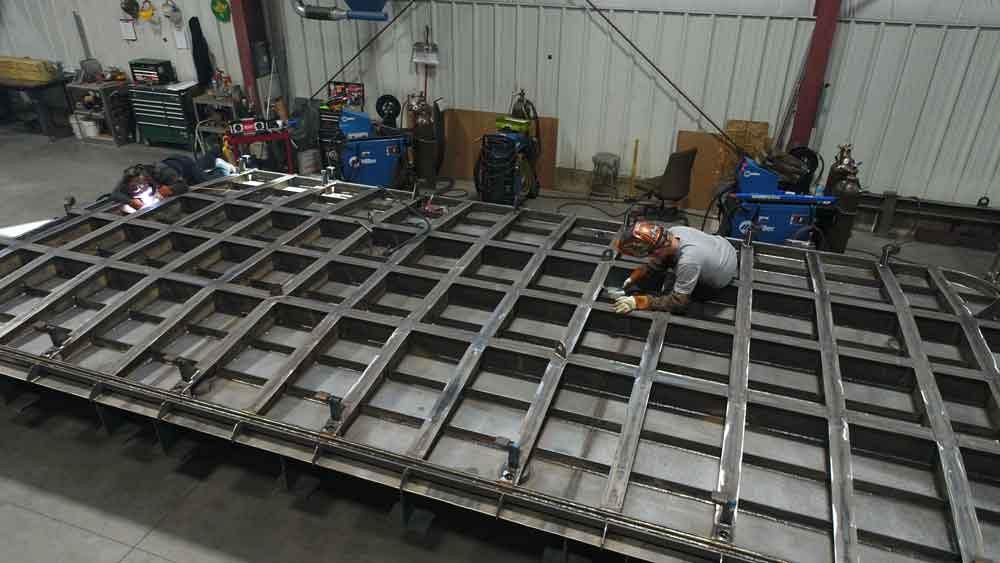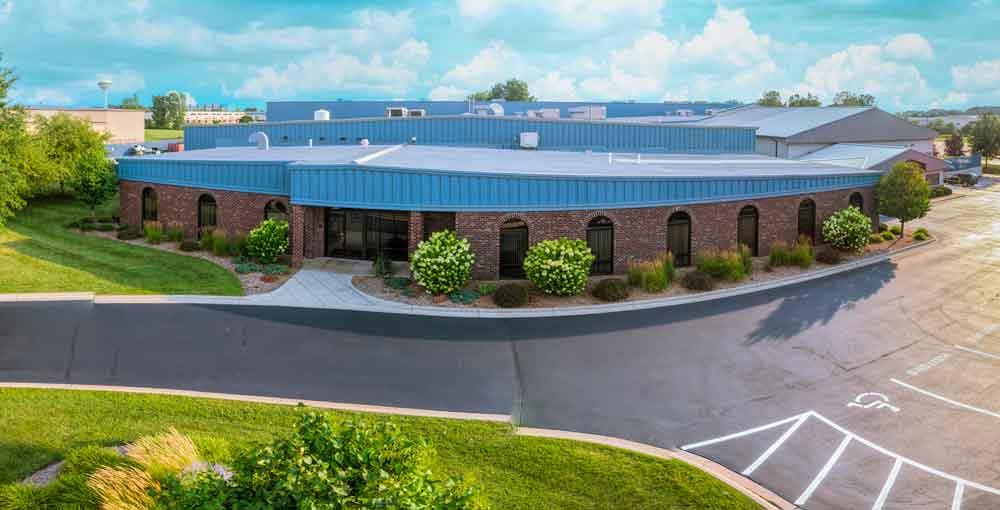Senior Editor
- FMA
- The Fabricator
- FABTECH
- Canadian Metalworking
Categories
- Additive Manufacturing
- Aluminum Welding
- Arc Welding
- Assembly and Joining
- Automation and Robotics
- Bending and Forming
- Consumables
- Cutting and Weld Prep
- Electric Vehicles
- En Español
- Finishing
- Hydroforming
- Laser Cutting
- Laser Welding
- Machining
- Manufacturing Software
- Materials Handling
- Metals/Materials
- Oxyfuel Cutting
- Plasma Cutting
- Power Tools
- Punching and Other Holemaking
- Roll Forming
- Safety
- Sawing
- Shearing
- Shop Management
- Testing and Measuring
- Tube and Pipe Fabrication
- Tube and Pipe Production
- Waterjet Cutting
Industry Directory
Webcasts
Podcasts
FAB 40
Advertise
Subscribe
Account Login
Search
Targeted metal fabrication
How one metal fabricator in Green Bay, Wis., grew with fewer customers
- By Tim Heston
- August 7, 2020
- Article
- Shop Management

Fox Valley Metal-Tech of Green Bay, Wis., has fewer customers than it did in 2018. Thing is, it also has more revenue and greater profits through targeted metal fabrication. Getty Images
Fox Valley Metal-Tech (FVMT) has fewer customers than it did four years ago, and for Kevin Gosselin, the Green Bay, Wis.-based company’s vice president of business development, that’s good news. Why? Because now the custom metal fabricator also has more revenue.
“I’m a firm believer that a select portfolio of high-value customers will help us grow the business more than a large number of low-value customers,” Gosselin said.
Improvement in metal fabrication occurs throughout the value chain, and at the beginning of the chain is business development. A fabricator with the most advanced lasers, press brakes, and welding systems can still fall on its face if it focuses on a customer base that doesn’t appreciate the shop’s strengths.
Over the past four years Gosselin and his team have refined FVMT’s customer base to match the company’s core strengths and, more broadly, help make the company be the kind of fabricator its employees and managers want it to be. “We’re not just looking for the next purchase order,” Gosselin said. “We’re looking for opportunities that have the potential to transform our business.”
The Customer Analysis
Defining a high-value customer can be a complex exercise. A high-value customer for FVMT might be a very low-value customer to another fabricator. Profitability is one common denominator—it’s hard to think of a high-value customer that’s unprofitable, at least over the long term—but it’s just one aspect. Volume is another aspect; demand duration and repeatability (how often customers order and for how long) are others; and the nature of the work (complexity, level of engineering, certifications, customer approval requirements) is another.
Historically, many custom fab shops have grown on the backs of several large customers. In the “Financial Ratios & Operational Benchmarking Survey” published annually by the Fabricators & Manufacturers Association, respondents usually report having between just four and seven customers making up 50% of revenue, on average. High revenue concentration is widely seen to increase risk, which is why so many fab shops try to diversify the customer base.
But “customer diversity” is also subjective. A certain mix of customers might be ideal for one fabricator but detrimental for another. Consider 247 TailorSteel, a fabricator that’s the polar opposite of FVMT. The Dutch company has automated most front-office functions. Thousands of different customers upload models of parts to a website, get a quote instantly, and receive their cut and bent parts within a few days. That said, in most cases the fabricator only laser-cuts and bends sheet metal. It does not offer welding, powder coating, or assembly (though it can subcontract some of these services). A customer who uploads an order for 50 pieces and then doesn’t submit another order for several months, quarters, or even years would for 247 TailorSteel still be a high-value customer. That’s because the customer’s occasional demand for low-volume work perfectly fits the 247 TailorSteel business model—but not FVMT’s. In fact, the last thing FVMT would want is to have a wide mix of customers occasionally order low volumes of quick-turn work.
This might sound counterintuitive. Why would a fabricator want fewer customers? Wouldn’t that increase risk? After all, many a fabricator has shuttered its doors because of this very problem. The shop launches and grows on the back of a few large customers concentrated in just a few industries; one industry goes south, several large customers pull work, and the fabricator struggles to survive.
“We [at FVMT] believe that risk can be mitigated by another important factor: value beyond price,” Gosselin said. “If the products and services provided help solve customers’ manufacturing issues, the value to customers increases.” He added that so does customer “stickiness”—that is, it would be difficult for a customer to leave for a competitor for price alone.
This added value can include design for manufacturability (DFM) and other aspects that solidify a fabricator-customer partnership. Still, such partnerships don’t always increase customer stickiness, particularly if a product isn’t terribly difficult to fabricate. Consider a situation in which a customer works with a fabricator and, through rigorous DFM, creates a part that’s much simpler to make. A year or two later, the customer’s new purchasing manager needs to save a few dollars, so he shops around for another fabricator to supply the part.

Fox Valley Metal-Tech has evolved to become a fabricator that specializes in large, complex fabrications for the military and similar customers. Image provided by FVMT
What would decrease the risk of the customer moving to another supplier? The supplier-customer relationship might have something to with it, particularly if it’s backed up by solid quality and delivery performance. But what if a competing fabricator has, say, a more powerful laser or bending automation that might make the parts even cheaper to fabricate? Of course, technology investment alone often isn’t enough. Most machines in metal fabrication aren’t proprietary to a single fab shop, and nothing can legally stop a competitor from buying the same machines and achieving the same productive power. As the late Dick Kallage, longtime industry consultant and former columnist for this magazine, once wrote, “Yesterday’s differentiators can be tomorrow’s commodity.”
What can increase that customer stickiness, where even just a few high-value customers wouldn’t risk breaking the supplier relationship? Enter another important variable: a market’s barrier to entry.
The Road Toward a High Barrier
FVMT was launched by three brothers-in-law in 1989. In 2004 it was acquired by a private investment group that included several of the company’s founders. What began as a 10,000-sq.-ft. sheet metal job shop is now a 110,000-sq.-ft. contract manufacturing operation.
It grew gradually as a general-purpose sheet metal job shop through the 1990s, but in the 2000s the order mix evolved. By 2006 it began to win more defense work, and by the 2010s the shop began to carve its niche around complex, high-value work, including large fabrications incorporating numerous manufacturing partners. Its products can be found on various defense platforms such as the U.S. Navy’s littoral combat ship, nuclear aircraft carriers, destroyers, and nuclear submarines. Many projects are monthslong endeavors. Such work requires a variety of certifications and stringent procedures qualified to various standards: AWS, NAVSEA, MIL-STD, and more.
“We have welding procedures documented and records for every weld type and every weld joint and material thickness and combination,” Gosselin said. “And in many cases, those must be submitted to the customer before we can proceed with welding. So it’s a whole different process from conventional fabrication.”
The planning and manufacturing process involves a lot of specifics, from detailed material certs to fully documented inspection procedures. Every engineering change requires the righ within several years t approvals and paper trail. “And all that is there for good reason,” Gosselin said. “It’s important work. We don’t successfully launch fighter jets off the deck of an aircraft carrier without making sure every feature is designed and manufactured to specifications.”
The nature of defense work isn’t a secret, but it has one benefit that helps differentiate FVMT from the crowd. “There are a lot of companies that see the carrot, but it takes a lot of work to be able to break into the space,” Gosselin explained. “It’s a barrier to entry that we have overcome.”
Focusing the Business
Five years ago FVMT had long since jumped over that barrier into a kind of specialty fabrication that included defense and other products of similar complexity. FVMT was still serving some customers that, truth be told, weren’t the greatest fit. Many simply weren’t profitable. It was no one’s fault, really. FVMT had changed, and it couldn’t go on being the general-purpose shop it once was.
“For a long time we quoted every customer that knocked on our door,” Gosselin said. “But in recent years we’ve been trying to reshape the business development focus so that we’re targeting high-value customers and industries.”
To start, Gosselin and his team conducted an 80/20 analysis, identifying the roughly 20% of customers (the “vital few” in the 80/20 rule) that provided roughly 80% of the value. These customers made up the top quartile of customers. From there the team ranked customers in the bottom three quartiles, and where these customers fell determined the next steps.

Most work at FVMT requires extensive design reviews and continual customer communication. Image provided by FVMT
When possible, they helped some customers find other suppliers who could better meet their needs. The team also re-evaluated its money-losing jobs. In some cases they tweaked shop processes to turn those money-losers into money-makers. In other cases, pricing issues had to be addressed. “And those customers have stayed onboard despite us raising prices where necessary,” Gosselin said.
Why, exactly? Gosselin said many times it had to do with the nature of the work those customers needed. “Not only on the defense side but also on the commercial side of our business, customers tend to come to us to solve critical or demanding challenges. Again, the stuff we do isn’t easy.” The fact these customers stayed on, even after FVMT raised prices, reaffirmed Gosselin’s assumption: The company’s niche improves customer stickiness.
Fabricating Amid a Pandemic
One might think that a fabricator culling its customer base before a pandemic and ensuing economic fallout might be a recipe for disaster. After all, isn’t this like putting your eggs in fewer baskets? Well, not exactly. Yes, FVMT’s eggs are in fewer baskets, but the company knows those baskets inside and out—and those baskets have been holding their own during the current economic crisis.
“Generally speaking, I would say that the effect [from the pandemic] for us has been minimal,” Gosselin said. “Upwards of 65% of our revenue base comes from defense contracts, so as a defense contractor, we’ve remained open for the entire time. And we continue to meet our customers’ needs, both on the defense and commercial sides of the business.
“There have been a few delays in some areas of the supply chain, because some of our supply chain partners are small companies and may not have been able to get the same declaration of an essential business as we were able to get,” he continued. “Still, the delays haven’t been to any detrimental extent.” He added that the pandemic also hasn’t called into question FVMT’s business development strategy. If anything, the crisis has helped solidify it.
The fabricator’s story of business development exemplifies the custom metal fabrication industry’s push away from commoditization, where the supplier-customer relationship is transactional and centered around price. Even 247 TailorSteel, FVMT’s polar opposite, doesn’t see itself as offering a commodity service. Customers buy from the company not for a low price (though it’s a factor) but because of the easy experience: Upload a file, get a price, and in three days get a part.
On the other hand, FVMT is at home with projects that might last two, three, even eight months. The ability to deliver highly engineered, challenging, critical projects is a key differentiator. That said, differentiation is in the eyes of the beholder, the target audience. A shop loses its focus when it strays from the needs of its target customers. It can try being everything to everybody, but it probably won’t be as successful or profitable.
“We began our [customer targeting efforts] in 2017, and we’re now seeing the results,” Gosselin said. “In 2019 we grew our revenue and increased our profitability, but we did it with fewer customers than we had in 2018. We now have a greater number of high-value customers.
“And we’re poised for growth. We’ve got contracts that should come to fruition during the second half of the year. We’re staffing up as much as we can, both on the shop floor and in management, to be able to support those programs.”
Last year Gosselin would have been one among many shop managers with rosy outlooks for both the short and long term. In 2020 such rosy outlooks have much less company.
About the Author

Tim Heston
2135 Point Blvd
Elgin, IL 60123
815-381-1314
Tim Heston, The Fabricator's senior editor, has covered the metal fabrication industry since 1998, starting his career at the American Welding Society's Welding Journal. Since then he has covered the full range of metal fabrication processes, from stamping, bending, and cutting to grinding and polishing. He joined The Fabricator's staff in October 2007.
subscribe now

The Fabricator is North America's leading magazine for the metal forming and fabricating industry. The magazine delivers the news, technical articles, and case histories that enable fabricators to do their jobs more efficiently. The Fabricator has served the industry since 1970.
start your free subscription- Stay connected from anywhere

Easily access valuable industry resources now with full access to the digital edition of The Fabricator.

Easily access valuable industry resources now with full access to the digital edition of The Welder.

Easily access valuable industry resources now with full access to the digital edition of The Tube and Pipe Journal.
- Podcasting
- Podcast:
- The Fabricator Podcast
- Published:
- 04/16/2024
- Running Time:
- 63:29
In this episode of The Fabricator Podcast, Caleb Chamberlain, co-founder and CEO of OSH Cut, discusses his company’s...
- Trending Articles
How to set a press brake backgauge manually

Capturing, recording equipment inspection data for FMEA

Tips for creating sheet metal tubes with perforations

Are two heads better than one in fiber laser cutting?

Hypertherm Associates implements Rapyuta Robotics AMRs in warehouse

- Industry Events
16th Annual Safety Conference
- April 30 - May 1, 2024
- Elgin,
Pipe and Tube Conference
- May 21 - 22, 2024
- Omaha, NE
World-Class Roll Forming Workshop
- June 5 - 6, 2024
- Louisville, KY
Advanced Laser Application Workshop
- June 25 - 27, 2024
- Novi, MI



























